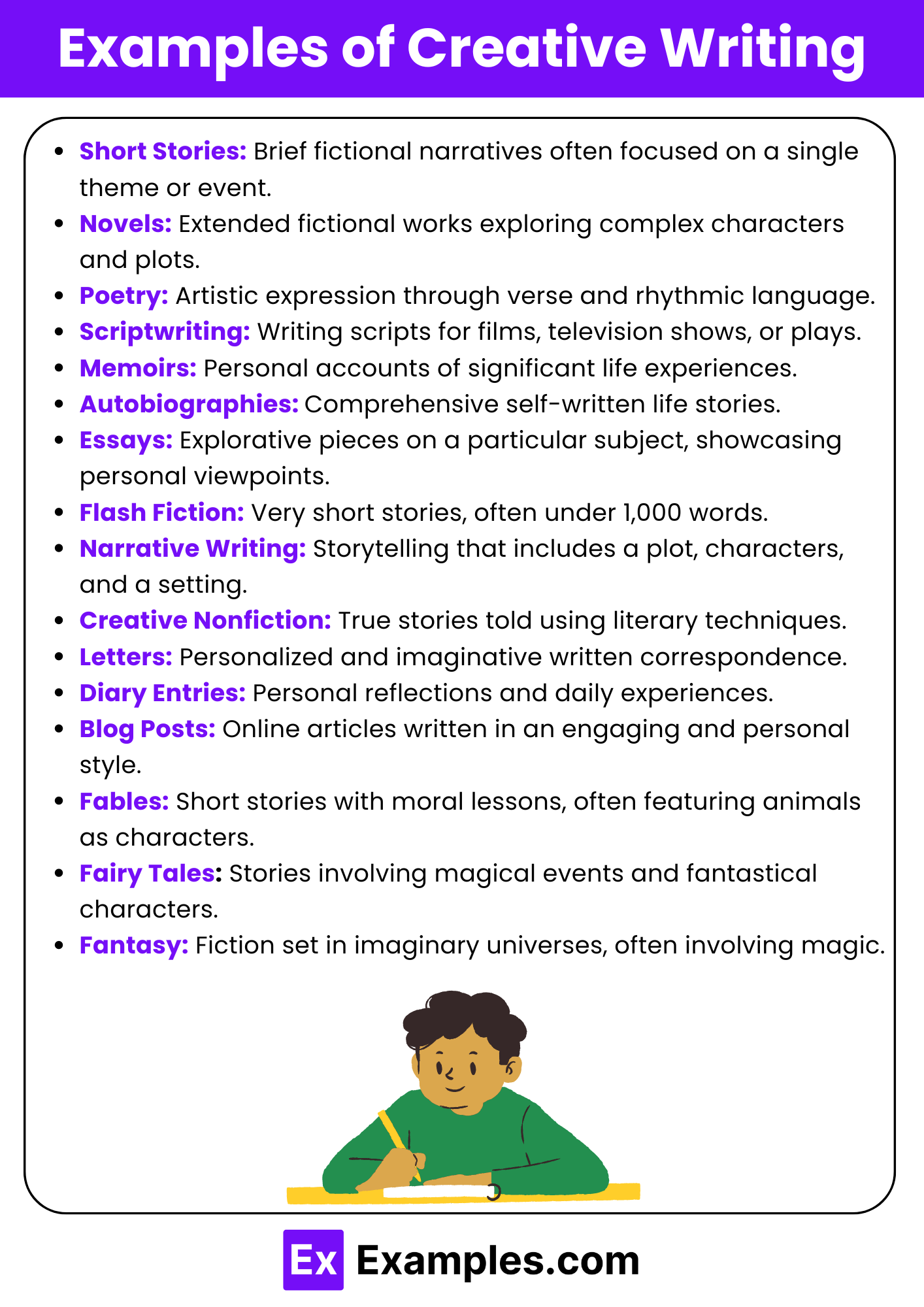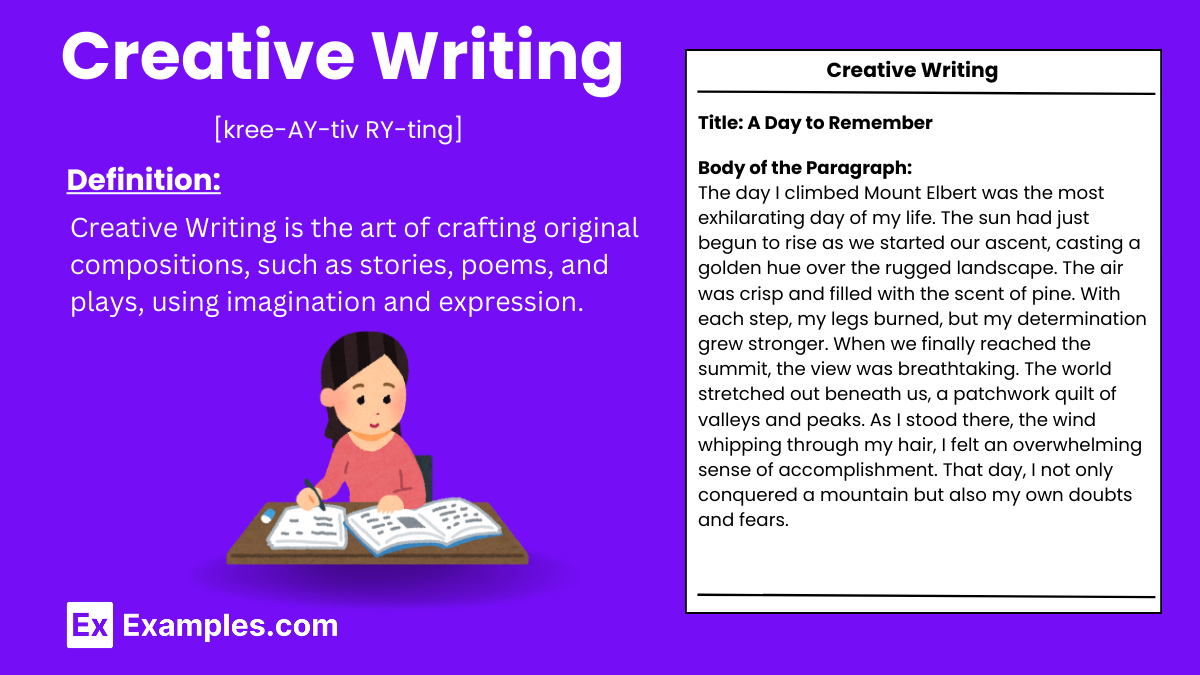20+ Creative Writing Examples
Creative writing is a form of artistic expression that goes beyond the bounds of traditional literature. It encompasses various genres and styles, including scriptwriting, narrative writing, and article writing, allowing writers to explore and convey their imaginations vividly. This form of writing also includes creating a creative bio, where writers introduce themselves in unique and engaging ways. Creative writing not only hones one’s ability to tell compelling stories but also enhances critical thinking and emotional expression.
What is Creative Writing?
Creative writing is the art of crafting original content through imaginative expression, including genres like scriptwriting, narrative writing, and article writing. It involves the creation of engaging and innovative texts that showcase a writer’s creativity and unique voice.
Examples of Creative Writing

- Short Stories: Brief fictional narratives often focused on a single theme or event.
- Novels: Extended fictional works exploring complex characters and plots.
- Poetry: Artistic expression through verse and rhythmic language.
- Scriptwriting: Writing scripts for films, television shows, or plays.
- Memoirs: Personal accounts of significant life experiences.
- Autobiographies: Comprehensive self-written life stories.
- Essays: Explorative pieces on a particular subject, showcasing personal viewpoints.
- Flash Fiction: Very short stories, often under 1,000 words.
- Narrative Writing: Storytelling that includes a plot, characters, and a setting.
- Creative Nonfiction: True stories told using literary techniques.
- Letters: Personalized and imaginative written correspondence.
- Diary Entries: Personal reflections and daily experiences.
- Blog Posts: Online articles written in an engaging and personal style.
- Fables: Short stories with moral lessons, often featuring animals as characters.
- Fairy Tales: Stories involving magical events and fantastical characters.
- Fantasy: Fiction set in imaginary universes, often involving magic.
- Science Fiction: Speculative fiction often dealing with futuristic concepts.
- Song Lyrics: Written words designed to be sung, expressing emotions and stories.
- Speeches: Written for public speaking, aiming to inspire or inform.
- Creative Bio: Engaging and unique personal introductions for authors or professionals.
Creative Writing Examples for Students
1. A Day in the Life of a Superhero
Title: The Amazing Adventures of Lightning Girl
Lightning Girl woke up to the sound of her alarm clock buzzing. She stretched her arms and smiled, ready to save the world. She put on her blue and yellow suit, laced up her boots, and flew out the window. Her first mission was to stop a runaway train. With a flash of lightning, she zoomed to the scene, using her super speed to bring the train to a safe stop. The passengers cheered, and Lightning Girl felt proud.
2. A Magical Journey
Title: The Enchanted Forest
One sunny morning, Mia discovered a hidden path in her backyard. Curious, she followed it and found herself in an enchanted forest. The trees sparkled with magic, and the animals could talk. A friendly fox named Felix greeted her. He guided Mia to the Fairy Queen, who needed help finding a lost treasure. Together, they ventured through the forest, solving riddles and overcoming obstacles. Mia used her bravery and kindness to succeed. When she found the treasure, the Fairy Queen granted her a wish.
Creative Writing Examples for High School
1. A Dystopian World
Title: The Last City
In the year 2150, the world had changed. Natural disasters and wars had destroyed most of the Earth, leaving only one city standing – Arka. The city was enclosed by a massive dome to protect its inhabitants from the harsh conditions outside. Within Arka, life was strictly controlled by the government. Citizens were assigned jobs, and freedom was limited. Sarah, a young woman, dreamed of seeing the world beyond the dome.
2. A Time Travel Adventure
Title: The Time Traveler’s Dilemma
James was an ordinary high school student until he found a mysterious pocket watch in his grandfather’s attic. The watch had the power to transport him through time. One evening, James accidentally activated the watch and found himself in the year 1920. He witnessed life during the Roaring Twenties, experiencing the excitement and challenges of the era. However, he also discovered that his actions in the past could have serious consequences for the future. James had to navigate the complexities of time travel, learning valuable lessons about history, responsibility, and the impact of his choices.
Creative Writing Examples Short Stories
1. The Mysterious Key
Title: The Mysterious Key
Lucy loved exploring old antique shops. One day, she found an ornate key with intricate designs. The shopkeeper said it was part of a set, but he didn’t know what it opened. Intrigued, Lucy bought the key and began searching for its lock. She asked around town and discovered an old mansion on the outskirts that had been abandoned for years.
2. The Lost Puppy
Title: The Lost Puppy
Sam was walking home from school when he heard a whimpering sound. He followed it and found a small, frightened puppy hiding under a bush. The puppy had no collar, and no one in the neighborhood recognized it. Sam decided to take the puppy home and named it Max. He put up posters and asked around, but no one claimed the puppy. Over the weeks, Sam and Max became inseparable. Just when Sam thought he’d have to give Max up, a neighbor recognized the puppy from the posters.
Creative Writing Examples for Kids
1. A Talking Cat
Title: The Talking Cat
Once upon a time, there was a little girl named Lily who loved animals. One day, while walking in the park, she found a stray cat with bright green eyes. She took the cat home and named it Whiskers. To her surprise, Whiskers started talking! He told Lily that he was a magical cat who could talk to only kind-hearted children.
2. The Magical Treehouse
Title: The Magical Treehouse
Max and Mia were siblings who loved to play in their backyard. One day, they discovered an old treehouse they had never seen before. They climbed up and found a dusty book inside. When they opened the book, the treehouse began to shake and glow. Suddenly, they were transported to a magical land filled with talking animals, friendly giants, and enchanted forests.
Creative Writing Examples for College
1. The Existential Café
Title: The Existential Café
In a bustling city, there was a small café known only to a few. The café, called “The Existential,” attracted people searching for deeper meaning in life. One evening, Emma, a philosophy major, entered the café seeking solace from her overwhelming coursework. She met an older man named Henry, a former professor who frequented the café. They struck up a conversation about life, purpose, and the nature of existence. Their discussions became a weekly ritual, challenging Emma’s views and helping her grow intellectually and emotionally.
2. The Forgotten Manuscript
Title: The Forgotten Manuscript
Alex, an aspiring writer, stumbled upon an old, dusty manuscript in the basement of his university library. The manuscript was written by a little-known author from the 1920s and contained a gripping mystery novel that was never published. Fascinated, Alex decided to finish the story and publish it as a tribute to the original author. As he worked on the manuscript, he uncovered secrets about the author’s life, including a love affair and a mysterious disappearance.
Types of Creative Writing
Fiction: Fiction writing involves creating stories that are not real. This genre includes novels, short stories, and novellas. Fiction often explores themes, characters, and plots that captivate readers’ imaginations.
Poetry: Poetry is a form of writing that uses rhythmic and aesthetic qualities of language to evoke meanings. It often employs meter, rhyme, and other linguistic devices to convey emotions and ideas.
Creative Nonfiction: Creative nonfiction tells true stories using the techniques of fiction. This genre includes memoirs, autobiographies, personal essays, and narrative journalism. It blends factual accuracy with narrative flair.
Playwriting: Playwriting involves writing scripts for theatrical performances. It includes dialogue, stage directions, and character descriptions. Playwrights create works for the stage that are performed by actors.
Screenwriting: Screenwriting is the craft of writing scripts for movies and television. It includes the dialogue, actions, and expressions of characters, as well as directions for camera movements and settings.
Flash Fiction: Flash fiction is a very short form of storytelling, usually under 1,000 words. It focuses on brevity and clarity, often delivering a powerful impact in a concise format.
Expository Writing: Expository writing explains or informs. While not traditionally seen as creative, expository writing can be highly creative when presenting information in engaging ways.
Journaling: Journaling involves writing personal reflections, thoughts, and experiences. It can be a way to explore creativity and self-expression in an informal manner.
Letters: Letter writing, though less common today, is a form of creative expression that can be both personal and profound. It includes personal letters, open letters, and epistolary novels (novels written as a series of letters).
Songwriting: Songwriting combines lyrical writing with music. Lyrics can be poetic, narrative, or abstract, and they work in harmony with musical composition to create songs.
Tips for Creative writing
- Read Widely and Often
- Write Regularly
- Keep a Journa
- Show, Don’t Tell
- Create Strong Characters
- Use Dialogue Effectively
- Embrace the Editing Process
How can I improve my creative writing skills?
Read widely, write regularly, and seek feedback. Practice different genres, including Memo Writing and Report Writing, to enhance your versatility.
Can creative writing help in Memo Writing?
Yes, creative writing enhances narrative skills, making Memo Writing more engaging and effective through improved storytelling techniques.
How does creative writing differ from Report Writing?
Creative writing focuses on imaginative storytelling, while Report Writing presents factual information. Both require clear, compelling language.
Why is ‘show, don’t tell’ important in creative writing?
‘Show, don’t tell’ creates vivid imagery and emotions, drawing readers into the story and enhancing engagement.
Can creative writing improve Report Writing?
Yes, creative writing hones clarity and expression, making Report Writing more compelling and readable.
What role does dialogue play in creative writing?
Dialogue reveals character traits, advances the plot, and creates realistic interactions, adding depth to your writing.
What inspires creative writing?
Inspiration can come from personal experiences, observations, other literary works, and even Memo Writing or Report Writing.
How important is editing in creative writing?
Editing is crucial. It refines your work, improves clarity, and ensures your story resonates with readers.
What is the best way to start a creative writing piece?
Start with a compelling opening that grabs attention, such as an intriguing question, vivid description, or dramatic event.
Why join a writing community?
Writing communities offer support, feedback, and inspiration, helping you grow as a writer in both creative and professional contexts like Memo Writing and Report Writing.



